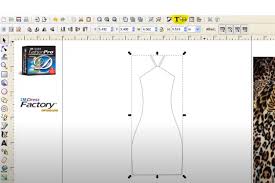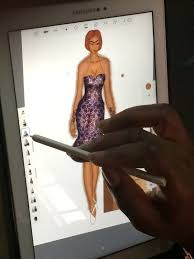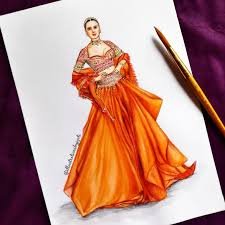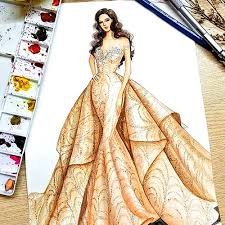What is Digital Fashion Designing? What Skills Do You Need to Be A Digital Fashion Designer? Does Digital Fashion Have A Great Future?
Digital fashion designing refers to the process of creating and designing clothing using digital software tools, rather than traditional physical methods. This field of fashion design has seen significant growth in recent years due to the availability of powerful digital software and technological advancements.
Digital fashion designers use a variety of software tools, such as Adobe Photoshop and Illustrator, to create their designs. These tools allow them to manipulate and create images of garments, experiment with different colors and fabrics, and create detailed sketches of their designs. Digital fashion designers can also use 3D software such as Marvelous Designer, CLO 3D, and Browzwear to create virtual garments that can be used in fashion simulations and animations.

The benefits of digital fashion designing are numerous. Firstly, it allows designers to create and experiment with designs more quickly and efficiently than traditional methods. This can save time and money in the design process, as well as making it easier to make changes and revisions to designs. Digital fashion design tools also allow designers to work remotely, collaborate with other designers around the world, and share their work with clients and customers.
Another benefit of digital fashion designing is sustainability. The fashion industry is one of the largest contributors to environmental pollution, and digital fashion design can help reduce waste by eliminating the need for physical samples and prototypes. Digital designs can also be easily modified and updated, reducing the need for new designs and reducing the amount of waste created by outdated or unsold designs.
Digital fashion design is also becoming increasingly important in the retail industry. Many retailers are now using virtual and augmented reality tools to create immersive shopping experiences for customers, allowing them to see how clothing will look and fit before making a purchase. Digital fashion design is also being used to create custom-fit clothing, allowing customers to order clothing that is tailored to their specific measurements.

However, there are also some challenges associated with digital fashion design. One of the biggest challenges is the need for designers to have a strong understanding of digital software tools, which can be complex and require significant training to use effectively. Additionally, some designers may feel that digital design tools limit their creativity, as they may prefer to work with physical materials and fabrics.
In conclusion, digital fashion designing is a rapidly growing field that offers numerous benefits for designers, retailers, and consumers alike. The use of digital software tools can help streamline the design process, reduce waste, and create innovative shopping experiences. However, it is important for designers to balance the benefits of digital design with the need for traditional physical materials and techniques, in order to create truly innovative and sustainable fashion designs.
What Skills Do You Need to Be A Digital Fashion Designer?
To be a successful digital fashion designer, there are several key skills that you need to have. These skills will enable you to effectively use digital design software tools to create innovative and sustainable fashion designs. Below are some of the most important skills required to be a digital fashion designer.

- Strong understanding of design principles: Before you can create successful digital designs, it’s important to have a strong understanding of design principles such as color theory, composition, and proportion. This will enable you to create designs that are visually appealing and balanced.
- Familiarity with digital design software: To create digital designs, you need to be proficient in digital design software tools such as Adobe Photoshop and Illustrator, as well as 3D software such as Marvelous Designer and CLO 3D. You should have experience in using these tools to create 2D and 3D designs and be comfortable with manipulating images, creating digital sketches, and working with different materials and textures.
- Technical skills: Being able to use software tools is not enough. You also need to have a good understanding of technical design and garment construction. Understanding the different types of stitches, fabrics, and sewing techniques will help you create designs that are not only visually appealing but also technically sound.
- Creativity: While digital fashion design requires technical skills, it also requires a high level of creativity. You need to be able to come up with innovative ideas and designs that are both unique and marketable.
- Attention to detail: Digital fashion design is all about creating designs that look great in real life. This means you need to have a keen eye for detail and be able to spot mistakes and inconsistencies. Being detail-oriented will also help you create designs that are functional and comfortable to wear.
- Communication skills: As a digital fashion designer, you’ll need to communicate your designs and ideas to other team members, clients, and customers. You should be able to articulate your design concepts clearly and be open to feedback and suggestions.
- Time management skills: Fashion design is a fast-paced industry, and deadlines are often tight. You need to be able to manage your time effectively to ensure that you meet project deadlines and deliver high-quality work.
- Adaptability: The fashion industry is constantly evolving, and digital fashion design is no exception. You should be adaptable and willing to learn new techniques and software tools as they become available.

In summary, digital fashion design requires a combination of technical skills, creativity, attention to detail, and communication skills. By developing these skills, you can become a successful digital fashion designer and create innovative and sustainable fashion designs that meet the needs of the industry and consumers alike.
Does Digital Fashion Have A Great Future?
Yes, digital fashion has a great future ahead. Digital fashion is a rapidly growing field that is transforming the way that fashion is created, produced, and consumed. Below are some of the reasons why digital fashion is poised to have a great future.

- Sustainability: One of the biggest advantages of digital fashion is its potential to reduce waste and promote sustainability. Digital design tools eliminate the need for physical samples and prototypes, which reduces waste and the environmental impact of the fashion industry. Digital fashion also allows for customization and on-demand production, which can reduce overproduction and excess inventory.
- Speed and Efficiency: Digital fashion design allows designers to create and experiment with designs quickly and efficiently. This can save time and money in the design process, as well as making it easier to make changes and revisions to designs. Digital fashion design tools also allow designers to work remotely, collaborate with other designers around the world, and share their work with clients and customers.
- Immersive Shopping Experiences: Retailers are increasingly using virtual and augmented reality tools to create immersive shopping experiences for customers. These experiences allow customers to see how clothing will look and fit before making a purchase. Digital fashion design is also being used to create custom-fit clothing, allowing customers to order clothing that is tailored to their specific measurements.
- Digital Fashion Influencers: With the rise of social media platforms like Instagram, digital fashion influencers are becoming increasingly important. These influencers use digital design tools to create unique and innovative fashion designs, which are shared and admired by millions of people around the world. Digital fashion influencers are also able to collaborate with designers and retailers to create new collections and products.
- Accessibility: Digital fashion is making fashion more accessible to people around the world. Digital design tools allow designers to create designs that can be easily shared and reproduced, allowing for a more global and diverse fashion industry. Digital fashion also allows for on-demand production, which can make fashion more affordable and accessible to people who may not have been able to afford it before.
- Innovation: Digital fashion is a field that is constantly evolving and innovating. New technologies and software tools are being developed all the time, which are allowing designers to create even more innovative and sustainable fashion designs. For example, 3D printing technology is being used to create fashion designs using recycled materials, which has the potential to revolutionize the way that fashion is produced and consumed.

In conclusion, digital fashion has a great future ahead. With its potential to promote sustainability, increase efficiency, and create immersive shopping experiences, digital fashion is transforming the fashion industry in exciting and innovative ways. As technology continues to evolve, we can expect to see even more innovations and developments in the field of digital fashion.
What Skills Do You Need to Be A Digital Fashion Designer?
To be a successful digital fashion designer, there are several key skills that you need to have. These skills will enable you to effectively use digital design software tools to create innovative and sustainable fashion designs. Below are some of the most important skills required to be a digital fashion designer.

- Strong understanding of design principles: Before you can create successful digital designs, it’s important to have a strong understanding of design principles such as color theory, composition, and proportion. This will enable you to create designs that are visually appealing and balanced.
- Familiarity with digital design software: To create digital designs, you need to be proficient in digital design software tools such as Adobe Photoshop and Illustrator, as well as 3D software such as Marvelous Designer and CLO 3D. You should have experience in using these tools to create 2D and 3D designs and be comfortable with manipulating images, creating digital sketches, and working with different materials and textures.
- Technical skills: Being able to use software tools is not enough. You also need to have a good understanding of technical design and garment construction. Understanding the different types of stitches, fabrics, and sewing techniques will help you create designs that are not only visually appealing but also technically sound.
- Creativity: While digital fashion design requires technical skills, it also requires a high level of creativity. You need to be able to come up with innovative ideas and designs that are both unique and marketable.
- Attention to detail: Digital fashion design is all about creating designs that look great in real life. This means you need to have a keen eye for detail and be able to spot mistakes and inconsistencies. Being detail-oriented will also help you create designs that are functional and comfortable to wear.
- Communication skills: As a digital fashion designer, you’ll need to communicate your designs and ideas to other team members, clients, and customers. You should be able to articulate your design concepts clearly and be open to feedback and suggestions.
- Time management skills: Fashion design is a fast-paced industry, and deadlines are often tight. You need to be able to manage your time effectively to ensure that you meet project deadlines and deliver high-quality work.
- Adaptability: The fashion industry is constantly evolving, and digital fashion design is no exception. You should be adaptable and willing to learn new techniques and software tools as they become available.

In summary, digital fashion design requires a combination of technical skills, creativity, attention to detail, and communication skills. By developing these skills, you can become a successful digital fashion designer and create innovative and sustainable fashion designs that meet the needs of the industry and consumers alike.
Does Digital Fashion Have A Great Future?
Yes, digital fashion has a great future ahead. Digital fashion is a rapidly growing field that is transforming the way that fashion is created, produced, and consumed. Below are some of the reasons why digital fashion is poised to have a great future.

- Sustainability: One of the biggest advantages of digital fashion is its potential to reduce waste and promote sustainability. Digital design tools eliminate the need for physical samples and prototypes, which reduces waste and the environmental impact of the fashion industry. Digital fashion also allows for customization and on-demand production, which can reduce overproduction and excess inventory.
- Speed and Efficiency: Digital fashion design allows designers to create and experiment with designs quickly and efficiently. This can save time and money in the design process, as well as making it easier to make changes and revisions to designs. Digital fashion design tools also allow designers to work remotely, collaborate with other designers around the world, and share their work with clients and customers.
- Immersive Shopping Experiences: Retailers are increasingly using virtual and augmented reality tools to create immersive shopping experiences for customers. These experiences allow customers to see how clothing will look and fit before making a purchase. Digital fashion design is also being used to create custom-fit clothing, allowing customers to order clothing that is tailored to their specific measurements.
- Digital Fashion Influencers: With the rise of social media platforms like Instagram, digital fashion influencers are becoming increasingly important. These influencers use digital design tools to create unique and innovative fashion designs, which are shared and admired by millions of people around the world. Digital fashion influencers are also able to collaborate with designers and retailers to create new collections and products.
- Accessibility: Digital fashion is making fashion more accessible to people around the world. Digital design tools allow designers to create designs that can be easily shared and reproduced, allowing for a more global and diverse fashion industry. Digital fashion also allows for on-demand production, which can make fashion more affordable and accessible to people who may not have been able to afford it before.
- Innovation: Digital fashion is a field that is constantly evolving and innovating. New technologies and software tools are being developed all the time, which are allowing designers to create even more innovative and sustainable fashion designs. For example, 3D printing technology is being used to create fashion designs using recycled materials, which has the potential to revolutionize the way that fashion is produced and consumed.

In conclusion, digital fashion has a great future ahead. With its potential to promote sustainability, increase efficiency, and create immersive shopping experiences, digital fashion is transforming the fashion industry in exciting and innovative ways. As technology continues to evolve, we can expect to see even more innovations and developments in the field of digital fashion.








